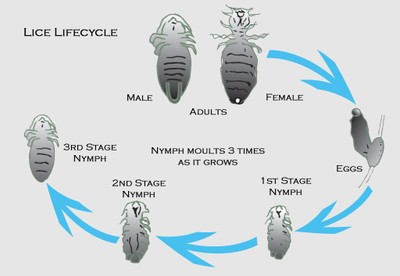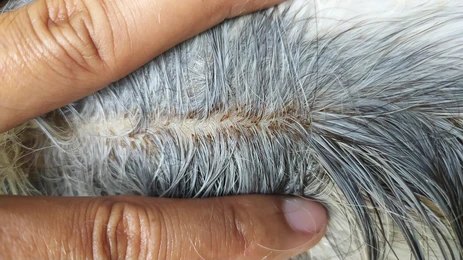Wondering, can dogs get lice? Yes they can, but don’t worry! Rodents (including chewing lice) on dogs can be controlled as long as the right method is used. Head lice are easy to treat at home, just use a special shampoo and brush.If you want to learn how to get rid of lice on dogs, start by using proven methods to get rid of lice quickly and effectively.
This guide covers everything you need to know, from understanding dog lice to natural remedies and DIY solutions. Read on to learn about the best lice treatments for dogs and how to protect your furry friend from a lice infestation!
Why and how dogs get lice
Dogs can get lice, but it’s less common compared to fleas or ticks. Lice thrive in unsanitary and crowded spaces, making cleanliness crucial for prevention.. Unlike other parasites, lice are slow-moving and lay eggs, called nits, which attach firmly to individual hair shafts. This means lice on dogs typically spread through direct contact with an infested animal or contaminated items like bedding or grooming tools.
Some common sources of lice infestations in dogs include:
Grooming salons, doggy daycares, and kennels
Shared bedding, blankets, or crates in multi-dog homes
Borrowed collars, brushes, or other grooming supplies
What dog lice are and how they spread
Dog lice are small, wingless, six-legged insects that live in the fur of animals and humans. But, dog lice are different from human & cat lice.
Lice are species-specific. They rely on certain body temperatures and conditions to survive. This means that dog lice only infest dogs. So, your canine friends cannot get lice from humans (head lice) and vice versa.
7 clear signs your dog might have lice
There are three species of lice that may infest your dog:
Heterodoxus spiniger (dog-chewing louse)
Trichodectes canis (dog-chewing louse
Linognathus setosus (dog-sucking louse)
Chewing Lice
The good news is that all types of dog lice are easy to treat and prevent. These lice fall into two categories: chewing lice and sucking lice.
Chewing lice feed on skin debris, like dead skin and dirt, making them more likely to infest dogs in unclean environments. The more debris, the more food they have to survive.
Although chewing lice don’t intend to harm your dog, they can cause significant irritation. These scavengers crawl across your dog’s skin and attach their eggs to hair shafts, leading to:
Skin irritation and redness
Hair matting or loss
Constant discomfort
Potential infections or disease
Biting or Sucking Lice
These lice feed on the blood of their hosts, biting and sucking with their sharp, piercing mouthparts. These wounds can act as entry points for bacteria, increasing the risk of infection or disease. Diseases such as worms or tapeworms can affect your dog’s health.
The Life Cycle of Dog LiceLice eggs (nits):
Female lice lay several eggs daily, which are sticky and attach securely to your dog’s hair shafts to ensure they stay in place.
Lice nymphs: After a couple of weeks, the eggs hatch into nymphs, which are smaller versions of adult lice but cannot reproduce.
Adult lice: Once fully matured, the lice are ready to spread, infesting your dog and potentially your home.
What’s the Difference Between Lice and Fleas?
If your dog is itching it can mean several things — from parasites to allergies. So, identifying your pet’s health issue can be difficult. When it comes to lice and fleas, there are distinct differences that can help you determine the cause of your dog’s discomfort.
Mobility
Fleas are quick and can jump between hosts with ease, while lice are less mobile, using their mouths to cling tightly to hair shafts.
Size
Both lice and fleas are small, measuring around 2-4 mm and visible to the naked eye up close. However, fleas have rounder bodies designed for feeding on animal blood.
Evidence
Fleas leave behind visible waste, known as flea dirt, which resembles black pepper specks on your pet’s fur. Lice, on the other hand, are scavengers that feed on dead skin but leave sticky, round nits attached to your pet’s hair.
Popularity
Lice are far less common than fleas and are typically contracted from strays, neglected pets in boarding facilities, or dogs in poor health.
7 Ways to Tell if Your Dog Has Lice
Identifying lice on dogs can be challenging, as they are often mistaken for dandruff or flakes of dead skin. However, lice that infest dogs have distinct and recognizable signs.
The most common symptoms and signs of lice in dogs include:
Living or dead lice on your dog’s coat
Frequent scratching, biting, or restlessness
Hair loss around the neck, ears, shoulders, or groin
Rough, dry, or tangled fur
Skin redness, irritation, or discomfort
Open sores or bacterial skin infections
Potential tapeworm infestations
If you suspect your dog has lice, don’t worry. With proper treatment, lice can be eliminated within 3-4 weeks. Plus, preventing future infestations is entirely possible.

How to get rid of and prevent lice in dogs
Lice are more of a nuisance than a major health risk to your dog’s well-being.health. However, that doesn’t mean prevention should be overlooked. Achieving lasting lice control may take time, but it’s a straightforward process.
Follow these six steps for getting rid of lice infestations for good:
1. Remove adult lice and lice eggs.
Begin by brushing your dog thoroughly, focusing on areas like the neck, shoulders, groin, and ears. Use a flea comb to part the fur and check for lice. Carefully remove each louse and any nits attached to the hair shafts.
After removal, place the lice in a sealed container and soak your comb in hot, soapy water to kill any remaining lice. This also helps your veterinarian if your dog develops additional symptoms.
In more severe cases, trimming your dog’s coat might be necessary. Consider seeking help from a professional groomer or veterinarian for proper treatment and grooming.
2. Treat your pet with vet-quality flea and tick treatment.
It’s not always easy to remove every trace of a lice infestation, especially since eggs can hatch and continue developing for weeks. To ensure complete eradication, use a topical treatment to kill any remaining lice and prevent them from re-infesting your dog.
The best topical flea and tick treatments have specific active ingredients. These can include:
Imidacloprid
Pyrethrin
Permethrin
Selamectin
Fipronil
Most vet-approved products are both safe and effective for dogs, but they may not be suitable for cats. Always check the safety labels before use. There are various treatment methods available, so whichever you choose, be sure to follow the instructions carefully and administer it regularly each month.
3. Clean your pet, their bedding, and their environment.
It’s often best to dispose of or remove any infected belongings. However, if you prefer not to part with your pet’s items, washing them in hot water can effectively eliminate lice and eggs.
Bedding and blankets
Collars, bandanas, and leash
Plush toys
GroIf you bathe your pet, wait at least 48 hours after applying a vet-approved topical treatment before giving them a bath. Certain shampoos or degreasing soaps can strip the treatment and undo your progress.
Afterward, disinfect your pet’s environment and thoroughly clean your home. Vacuum high-traffic areas, including carpets, floors, and fabrics, to remove any lingering lice or eggs.
4. Treat other pets with topical treatments.
New eggs may hatch in the weeks following your initial treatment, so it’s crucial to continue treatment for at least a month. Make sure to protect other dogs in your household, as lice are species-specific.
If you have multiple dogs, it’s best to quarantine the infested one to prevent lice from spreading. Check each pet for signs of lice and treat them with a vet-approved product. Don’t forget to reward them with their favorite treat afterward!
5. Safeguard your home for re-infestation.
Consider using a household spray with an insect growth regulator (IGR), available in stores or online. Alternatively, you can contact a pest control service to apply pet-safe insecticides in and around your home to help prevent re-infestation.
6. Focus on your pet’s health.
Let’s be honest—lice are a hassle. But they don’t have to ruin your month. Preventing lice infestations in dogs is easy if you:
Ensure your pet enjoys a balanced,
healthy diet
Schedule regular vet check-ups




